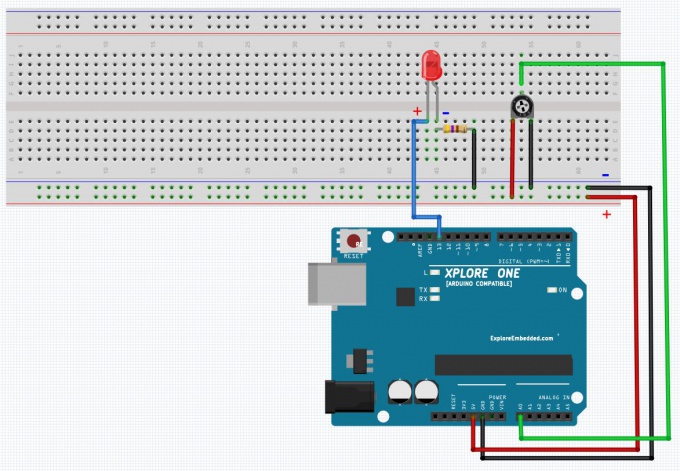Difference between revisions of "7 Blink LED with POT"
| (2 intermediate revisions by the same user not shown) | |||
| Line 4: | Line 4: | ||
<syntaxhighlight> | <syntaxhighlight> | ||
/* | /* | ||
| − | + | Blink LED with POT | |
Demonstrates analog input by reading an analog sensor on analog pin 0 and | Demonstrates analog input by reading an analog sensor on analog pin 0 and | ||
turning on and off a light emitting diode(LED) connected to digital pin 13. | turning on and off a light emitting diode(LED) connected to digital pin 13. | ||
| Line 41: | Line 41: | ||
delay(sensorValue); | delay(sensorValue); | ||
} | } | ||
| − | <syntaxhighlight> | + | </syntaxhighlight> |
Latest revision as of 16:48, 15 September 2014
Code
/* Blink LED with POT Demonstrates analog input by reading an analog sensor on analog pin 0 and turning on and off a light emitting diode(LED) connected to digital pin 13. The amount of time the LED will be on and off depends on the value obtained by analogRead(). The circuit: * Potentiometer attached to analog input 0 * center pin of the potentiometer to the analog pin * one side pin (either one) to ground * the other side pin to +5V * LED anode (long leg) attached to digital output 13 * LED cathode (short leg) attached to ground * Note: because most Arduinos have a built-in LED attached to pin 13 on the board, the LED is optional. */ int sensorPin = A0; // select the input pin for the potentiometer int ledPin = 13; // select the pin for the LED int sensorValue = 0; // variable to store the value coming from the sensor void setup() { // declare the ledPin as an OUTPUT: pinMode(ledPin, OUTPUT); } void loop() { // read the value from the sensor: sensorValue = analogRead(sensorPin); // turn the ledPin on digitalWrite(ledPin, HIGH); // stop the program for <sensorValue> milliseconds: delay(sensorValue); // turn the ledPin off: digitalWrite(ledPin, LOW); // stop the program for for <sensorValue> milliseconds: delay(sensorValue); }

